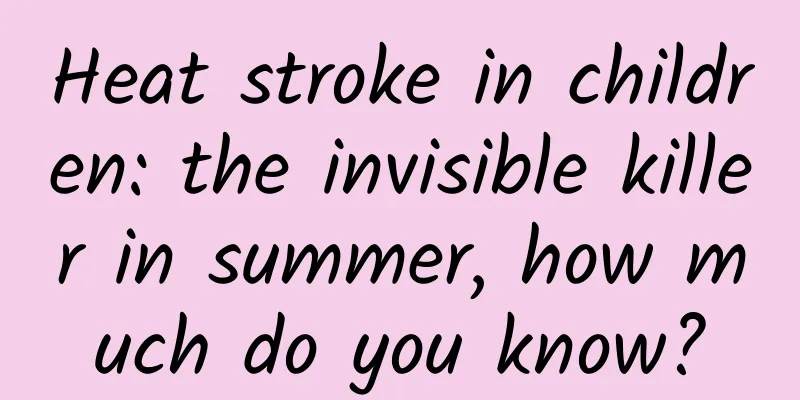Heat stroke in children: the invisible killer in summer, how much do you know?

|
Introduction: In the hot summer, beware of the dangers of heat As summer quietly approaches, high temperatures and scorching sun have become a common occurrence in our lives. However, in this sunny season, there is a "summer killer" that cannot be ignored - childhood heat stroke. It is like a cunning assassin, silently threatening the health and safety of children. Today, let us unveil the mystery of childhood heat stroke, understand its true face, and learn how to prevent and deal with it. 1. Heat stroke: the “ultimate form” of severe heat stroke What is heat stroke? Imagine that when the summer heat wave rolls in, your body seems to have turned into a furnace that cannot be cooled down. At this time, if the body's heat production and heat dissipation mechanisms lose balance, a crisis may quietly come - this is heat stroke. Simply put, heat stroke is the most serious stage of heat stroke, also known as heat shock or severe heat stroke. It is characterized by a sharp increase in core body temperature to above 40°C, accompanied by abnormalities of the central nervous system, such as confusion, convulsions or even coma, and damage to multiple organs, with a very high mortality rate. Two types of heat stroke: exertional and classic There are two main types of heat stroke: exertional heat stroke (EHS) and classic heat stroke (CHS). Exertional heat stroke is more common in healthy young people who perform high-intensity physical activities in high temperature and high humidity environments, such as athletes and soldiers; while classic heat stroke is more common in groups with insufficient body temperature regulation ability, such as children, the elderly, pregnant women and those with chronic diseases. Today, our protagonist is the "vulnerable group" in classic heat stroke - children. 2. Why are children a high-risk group for heat stroke? High heat generation and difficult heat dissipation Children are in a stage of rapid growth and development. Their metabolism is vigorous and their heat production capacity is higher than that of adults. At the same time, children's body temperature regulation center is not fully developed, and their sweating system is not sound, which makes it impossible for them to effectively dissipate heat through normal sweating. Therefore, in a high temperature environment, children are more likely to have a sharp rise in body temperature. Unclear expression, difficult to find in time Young infants and toddlers find it particularly difficult to express their discomfort, and even if they feel hot, they may be ignored by their parents because they cannot speak. This "silent crisis" makes it difficult to detect heat stroke in children in the early stages, thus missing the best time for intervention. Adult negligence and misunderstanding In addition to children's own physiological characteristics, some adults' improper behaviors also increase the risk of heat stroke in children. For example, they keep doors and windows closed for a long time for fear that children will catch a cold or get sick from the wind or air conditioning; or they put too many clothes on their children when taking them out for fear of sunburn; or even worse, they forget their children in a closed car, causing the temperature inside the car to rise rapidly and cause heat stroke. 3. Symptoms and warning signs of heat stroke High body temperature The most intuitive manifestation of heat stroke is a sharp rise in body temperature, usually over 40 degrees Celsius. At this time, the child will feel hot all over the body, and even radiate heat waves from the inside out. Impaired consciousness As the body temperature rises, the child's central nervous system will be affected, and symptoms such as confusion, convulsions, and coma will appear. Parents should be alert immediately if they find that their children suddenly become unresponsive, have dull eyes, or lose consciousness. Skin changes In a child with heat stroke, the skin becomes hot and dry because the body loses a lot of water and cannot sweat to dissipate the heat. But in heat stroke caused by intense exercise, the skin may also feel dry or slightly damp. Other symptoms In addition to the typical symptoms mentioned above, heat stroke may also be accompanied by nausea, vomiting, increased heart rate, rapid breathing, redness of the skin, etc. Parents should closely observe their children's physical condition and seek medical attention immediately if any abnormality is found. IV. Five strategies to prevent heat stroke in children 1. Avoid high temperature environment The most effective preventive measure is to avoid exposing children to high temperatures, high humidity and poor ventilation for a long time. Especially in the summer noon period (about 10 am to 4 pm), the sun's radiation is the strongest, so children should try to avoid going out. If they must go out, they should choose to walk in the shade and wear protective equipment such as sun hats and sunglasses. 2. Drink water promptly In hot weather, the human body is prone to sweating, which leads to a large loss of water and electrolytes in the body. Therefore, parents should encourage their children to drink more water to replenish the water and salt needed by the body. It is recommended to drink water in small amounts and multiple times to avoid discomfort caused by drinking a large amount of water at one time. At the same time, you can prepare some light salt water or mung bean soup and other drinks for your child to replenish electrolytes. 3. Dress appropriately In hot weather, children should wear loose, breathable, cotton clothes. Light-colored clothes can reflect sunlight and reduce heat absorption. Avoid dressing children in too many clothes or tight clothes to avoid affecting heat dissipation. In addition, you can also prepare a sun hat and a pair of sunglasses for your child to reduce direct sunlight on the eyes and head. 4. Arrange your work and rest schedule Ensuring adequate sleep is crucial to preventing heat stroke. Parents should arrange their children's daily routines appropriately to avoid strenuous exercise or heavy physical labor during high temperature periods. At the same time, they should also pay attention to maintaining indoor ventilation and a suitable temperature to create a good sleeping environment. 5. Be vigilant and avoid negligence Parents should always pay attention to their children's physical condition and changes in the surrounding environment. Never leave children alone in a closed car or other high-temperature environment. In addition, children should be taught how to identify and deal with discomfort in a high-temperature environment to improve their self-protection ability. 5. First aid measures for heat stroke Rapid cooling Once a child shows symptoms of heat stroke, take cooling measures immediately. First, move the child to a cool, ventilated place and lie down, unbuttoning the clothes to facilitate heat dissipation. Then, use a wet towel or cold water to wipe the child's body, especially the neck, armpits, and thighs where large blood vessels are distributed. If conditions permit, use ice packs or ice caps to cool down. But remember not to use inappropriate cooling methods such as wiping with alcohol or giving the child antipyretics. Keep your airways open Children with heat stroke may experience symptoms such as impaired consciousness and vomiting. During first aid, parents should ensure that the child's airway is open to prevent vomitus from blocking the airway. If the child has symptoms such as convulsions or coma, the head should be tilted to one side to prevent vomitus from being accidentally inhaled into the lungs. Seek medical attention promptly After taking initial cooling measures, you should immediately call 120 emergency number to send the child to the hospital for treatment. During the process of sending the child to the hospital, you should continue to take cooling measures and closely observe the changes in the child's condition. Conclusion: Protecting children’s health starts with preventing heat stroke Although heat stroke is terrible, as long as we are vigilant, do a good job of prevention and master the correct first aid methods, we can effectively avoid the harm it brings. Let us work together to create a safe and healthy summer environment for children! In this sunny season, I hope every child can grow up healthy and happy! |
<<: Get rid of the "liver" troubles in life, reduce sclerosis and enjoy a carefree life
>>: What should parents do if they discover that their child has refractive error?
Recommend
What to do if cervical erosion causes bleeding after sex
Sexual intercourse is supposed to be a very happy...
Chinese Cereals and Oils Association "Love and save grain, start with me" popular science pictures and texts - popular science on edible oil consumption
Produced by: Zhu Jincheng, Tianjin Cereals and Oi...
Don’t ignore oral ulcers, it is a disease that needs to be treated!
Oral ulcers are a very common oral mucosal diseas...
For elderly patients with simple elevated systolic blood pressure, will it be effective to use antihypertensive drugs that cost 4 cents per tablet?
"What? A bottle of 100 antihypertensive pill...
What to do about postpartum rheumatic fever?
Everyone knows that new mothers need to stay in c...
Can I eat instant noodles when I'm pregnant?
Instant noodles are a common type of instant nood...
What are the benefits of drinking coconut water for pregnant women?
Coconut shoes are a fresh tropical fruit native t...
How to make pickled cabbage fragrant? What are the techniques for stir-frying pickled cabbage?
Sauerkraut is a common food. There are many ways ...
Lower abdominal pain causes delayed menstruation
Many women may often encounter the situation of l...
How to treat a woman's yellow complexion
In daily life, if a woman suffers from insufficie...
Is cupping effective?
Uterine cold is a disease that plagues women with...
What are the symptoms of pyelonephritis in women?
Pyelonephritis is a very common disease. In recen...
Why do I have yellow discharge more than 40 days after a caesarean section?
As cesarean section technology becomes more and m...
Why has my frozen shoulder lasted so long? Why is the pain getting worse?
This is the 3550th article of Da Yi Xiao Hu Aunt ...
Why does itching of the vulva occur after uterine curettage?
Uterine curettage is very harmful to women's ...









